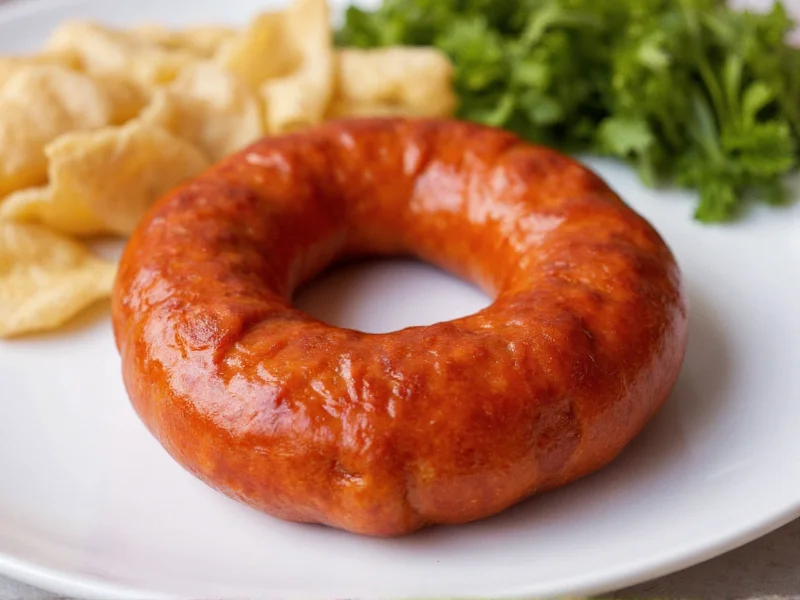When exploring what ring sausage is, it's essential to understand this unique sausage preparation that has stood the test of time across various culinary traditions. Unlike standard linear sausages, ring sausages form a continuous circle, creating distinctive presentation and cooking characteristics that set them apart from conventional sausage forms.
Understanding Ring Sausage: Definition and Characteristics
Ring sausage, most commonly represented by ring bologna, features a distinctive circular configuration where the sausage casing forms a complete loop. This preparation method creates several notable characteristics:
| Characteristic | Ring Sausage | Traditional Sausage |
|---|---|---|
| Shape | Circular ring formation | Straight links or bulk form |
| Cooking Method | Often fully cooked and smoked | Variety of preparations (fresh, smoked, cooked) |
| Serving Style | Sliced crosswise into "coins" | Sliced lengthwise or cooked whole |
| Traditional Use | Lunch meats, sandwiches, appetizers | Variety of culinary applications |
The most prevalent example of ring sausage is ring bologna, which typically measures 3-6 inches in diameter with a thickness of about 1-2 inches. This distinctive shape isn't merely aesthetic—it serves practical purposes in both production and consumption. The circular formation allows for even smoking and cooking throughout the sausage, while the compact shape makes it ideal for slicing into uniform rounds perfect for sandwiches or appetizers.
Historical Origins of Ring Sausage
Ring sausage preparation traces its roots to European sausage-making traditions, particularly in Germany and Eastern Europe. The ring bologna variety specifically evolved from Italian mortadella but was adapted by German immigrants in America who modified the recipe and shape. The circular formation likely developed as a practical solution for small-scale producers who needed to maximize shelf space while creating a product that was easy to handle and portion.
Historically, the ring shape served multiple purposes in traditional sausage making. It allowed butchers to hang sausages for smoking without the need for complex hooks or supports, as the continuous loop could be suspended from a single point. The shape also created structural integrity during the smoking process, preventing the sausage from sagging or deforming as it lost moisture.
Different Varieties of Ring Sausage
While ring bologna represents the most common ring sausage variety, several regional and specialty versions exist:
- Traditional Ring Bologna - Made from finely ground pork, beef, or a combination, seasoned with mild spices
- Beef Ring Sausage - Prepared exclusively with beef, often with stronger seasoning
- Smoked Ring Sausage - Features deeper smoke flavor through extended smoking process
- Ring Liver Sausage - Contains liver for richer flavor profile
- Ring Sausage with Cheese - Includes cheese chunks distributed throughout the ring
Regional variations appear across different culinary traditions. In some Eastern European countries, ring sausages incorporate distinctive spice blends featuring marjoram or allspice. American Midwest versions often maintain the German-inspired mild seasoning profile that makes ring bologna particularly versatile for sandwiches.
Production Process: How Ring Sausage is Made
The manufacturing process for ring sausage follows traditional sausage production with specific adaptations for the circular shape. High-quality ring sausage begins with selecting premium meats—typically a blend of pork and beef—that are finely ground to create the smooth texture characteristic of ring bologna.
After seasoning with a balanced blend of spices (usually including black pepper, nutmeg, and coriander), the meat mixture is stuffed into fibrous casings designed to hold the circular shape. The distinctive ring formation occurs when the sausage stuffer operator connects the beginning and end of the casing, creating a continuous loop that's then secured with special clips.
Following formation, ring sausages undergo a carefully controlled smoking process that typically lasts 6-12 hours at temperatures between 140-180°F. This slow smoking develops flavor while fully cooking the sausage, making it ready to eat without further preparation. The final product is then cooled, inspected, and packaged for distribution.
Culinary Applications and Cooking Methods
Ring sausage offers versatile culinary applications that take advantage of its distinctive shape. The most traditional preparation involves slicing the ring crosswise into 1/4 to 1/2 inch thick "coins" that maintain their circular shape. These slices work exceptionally well in sandwiches, particularly when paired with mustard, cheese, and hearty bread.
For cooking ring sausage, several methods yield excellent results:
- Cold serving - Since most ring sausages are fully cooked, they can be served cold directly from packaging
- Pan-frying - Heat slices in a skillet over medium heat for 2-3 minutes per side until golden
- Grilling - Place whole ring or slices on grill for 4-5 minutes per side
- Baking - Bake whole ring at 350°F for 15-20 minutes until heated through
- Appetizer preparation - Thread slices onto toothpicks with cheese cubes for simple hors d'oeuvres
When cooking ring sausage, maintain an internal temperature of 140°F for optimal texture and food safety. Overcooking can cause the sausage to become tough or crumbly. The ring shape creates even heating during cooking, which helps maintain consistent texture throughout the product.
Storage Guidelines for Ring Sausage
Proper storage ensures ring sausage maintains its quality and safety. Unopened ring sausages typically remain fresh for 2-3 weeks when refrigerated at or below 40°F. Once opened, consume within 7 days for best quality. For extended storage, freeze ring sausage in airtight packaging where it will maintain quality for 1-2 months.
When thawing frozen ring sausage, always use refrigerator thawing rather than room temperature methods to prevent bacterial growth. Never refreeze previously frozen ring sausage that has been fully thawed, as this compromises both texture and safety.











 浙公网安备
33010002000092号
浙公网安备
33010002000092号 浙B2-20120091-4
浙B2-20120091-4